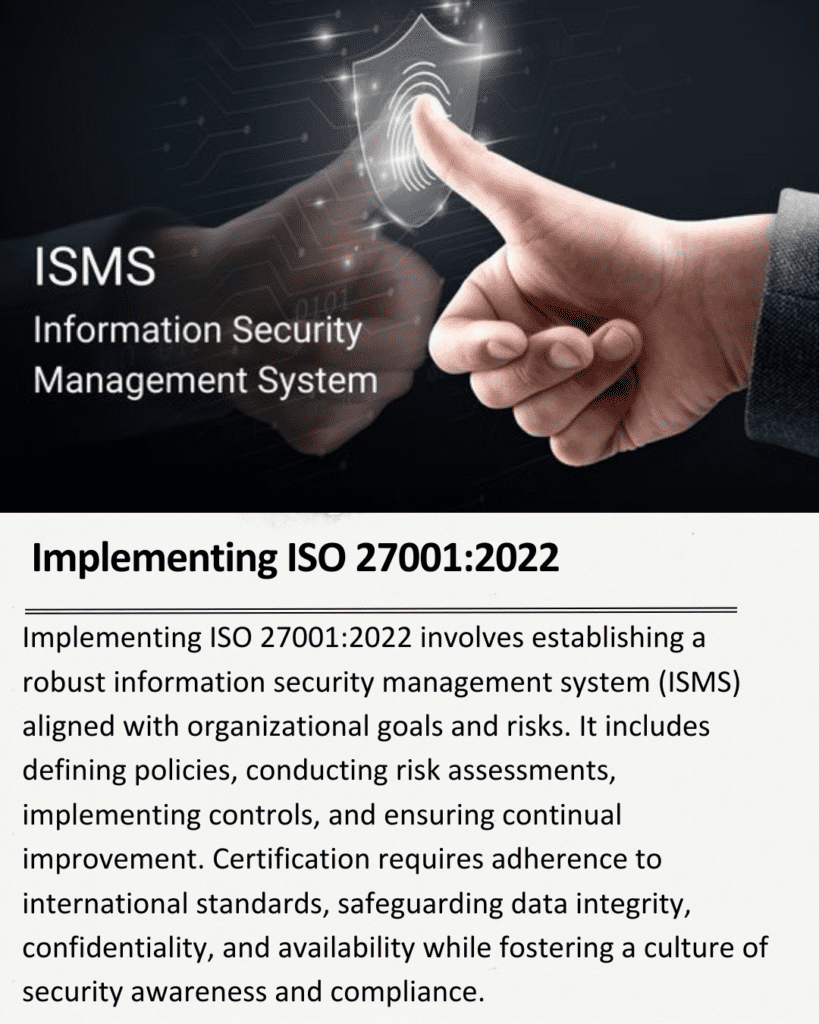Subtotal $0.00

Implementing ISO 27001:2022 involves a systematic approach to establish, implement, maintain, and continually improve an information security management system (ISMS) within an organization. This step-by-step guide outlines key elements and considerations for effectively implementing the new standard.
Step-by-Step Guide to Implementing ISO 27001:2022
1. Initiation and Commitment
Implementing ISO 27001 begins with commitment from top management to information security. This involves:
Leadership Commitment: Senior management must endorse and champion the implementation of ISO 27001, allocating necessary resources and support.
Establishing a Steering Committee: Form a team responsible for overseeing the implementation process, ensuring cross-functional involvement.
2. Gap Analysis
Conduct a comprehensive gap analysis to assess the organization’s current state of information security against ISO 27001 requirements:
Scope Definition: Define the scope of the ISMS, identifying boundaries, assets, and regulatory requirements.
Risk Assessment: Perform a thorough risk assessment to identify and evaluate information security risks.
Gap Identification: Compare current practices against ISO 27001 requirements to identify gaps and prioritize actions.
3. Planning
Develop an implementation plan based on the results of the gap analysis:
Objectives and Controls: Define measurable objectives aligned with business goals and select appropriate controls from Annex A of ISO 27001.
Resource Allocation: Allocate resources, including personnel, budget, and timeframes, to support implementation activities.
Documentation: Establish a documentation framework, including policies, procedures, and guidelines, tailored to the organization’s needs and scope.
4. Implementation
Execute the planned activities to establish the ISMS:
Training and Awareness: Conduct training sessions to raise awareness and build competency among employees regarding information security policies and procedures.
Implement Controls: Implement selected controls to mitigate identified risks, ensuring they are effectively integrated into operational processes.
Document Management: Establish document control procedures to manage ISMS documentation, ensuring accuracy, accessibility, and relevance.
5. Monitoring and Review
Monitor and review the ISMS to ensure its effectiveness and continual improvement:
Performance Monitoring: Implement mechanisms to monitor and measure the performance of the ISMS, including key performance indicators (KPIs) and internal audits.
Management Review: Conduct periodic reviews by top management to evaluate the ISMS’s performance, adequacy, and opportunities for improvement.
Corrective Actions: Address non-conformities and take corrective actions promptly to maintain the effectiveness of the ISMS.
6. Certification Readiness
Prepare for ISO 27001 certification, if desired:
Internal Audit: Conduct an internal audit to assess conformity with ISO 27001 requirements and identify areas for improvement.
Management Review Meeting: Hold a management review meeting to review the audit results, corrective actions, and readiness for certification.
Certification Audit: Engage an accredited certification body to perform a certification audit based on ISO 27001 requirements.
7. Continual Improvement
Ensure continual improvement of the ISMS:
Feedback and Lessons Learned: Solicit feedback from stakeholders and incorporate lessons learned to enhance the effectiveness of the ISMS.
Adaptation to Changes: Monitor changes in the organization, technology, and external threats to adapt the ISMS accordingly.
Stay Updated: Keep abreast of updates to ISO 27001 and emerging best practices in information security management.
Conclusion
Implementing ISO 27001:2022 requires dedication, systematic planning, and ongoing commitment from all levels of the organization. By following this step-by-step guide, organizations can establish a robust ISMS aligned with international standards, effectively mitigate information security risks, and demonstrate their commitment to protecting sensitive information and enhancing overall business resilience. Continual improvement and adaptation ensure that the ISMS remains relevant and effective in addressing evolving information security challenges and regulatory requirements.